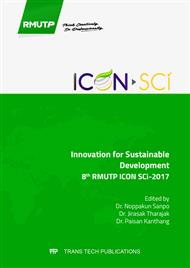p.27
p.32
p.41
p.47
p.51
p.57
p.62
p.71
p.78
The Acoustic Impedance and other Properties of (1-3) Piezoceramics Polymer Composite
Abstract:
The work is focused on an attempt to develop a route for the fabrication of piezoceamic-polymer composites having (1-3) type connectivity. The process included the extrusion of rods of diameter approximately 200 mm. A commercial piezoelectric, PC-5 was modified by addition of a lithium/bismuth based glass former together with excess PbO to lower the sintering temperature to about 1000 °C. The fast firing sintering was employed. The rods were assembled and impregnated with an epoxy resin to form 1-3 composites containing approximately 50 and 20 vol% piezoceramic. The measurement values showed that, the piezoelectric constant, d33 = 232 pCN-1 and 215 pCN-1, thickness electromechanical coupling coefficient, kt = 0.51 and 0.5 and the mechanical quality factor, Qm = 14 and 5 for the composites containg PZT rods at 50 vol% and 20 vol% respectively. Their acoustic impedances were 5.1 and 3.6 for the 50 vol% and 20 vol% of PZT rods respectively. The results show that with lower volume% of PZT could result in lower acoustic impedance which can be further improved for biomedical imaging and hydrophone applications.
Info:
Periodical:
Pages:
51-56
Citation:
Online since:
March 2018
Keywords:
Price:
Сopyright:
© 2018 Trans Tech Publications Ltd. All Rights Reserved
Share:
Citation:


